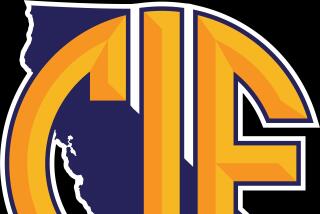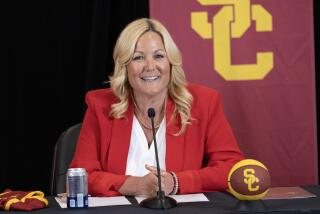College Athletics in a Run for Its Money
- Share via
When Seawolf and Sonoma Slew leave the starting gate as planned this summer at the Sonoma County Fair, they will carry more than a jockey: The hopes of an entire college athletic department will ride on their backs.
The thoroughbreds are part of an unorthodox fundraising effort benefiting sports programs at Sonoma State University -- one that officials say could generate as much as $200,000.
Sonoma’s NCAA-approved venture into racing late last year demonstrates the creative steps that athletic programs are taking to stay in business as the state cuts funding to colleges and universities. Whether organizing fundraising walks, summer camps, barbecues or silent auctions, athletic directors say they are turning into nearly full-time fundraisers.
Gov. Arnold Schwarzenegger’s proposed 2004-05 budget calls for $6.8 billion in statewide spending cuts, roughly $524 million coming from higher education. Intercollegiate athletic programs would lose between 8% and 10% of their funds, and administrators are planning for the worst.
A few institutions -- such as UCLA, with a $4-million reserve -- have weathered the storm, but most campuses in the University of California and California State University systems are scrambling to maintain scholarship levels and avoid laying off coaches and other personnel.
They are limiting long-distance calls, booking teams into cheap hotels, leaving positions vacant and, in the case of Cal State Fullerton, training volunteer senior citizens to sell tickets and provide security. A handful of schools have dropped sports and several others say they might do the same.
San Jose State is considering replacing three as-yet unnamed sports with some that cost less to operate. “When you are already at bare bones,” Athletic Director Chuck Bell said, “this is like amputation.”
California is not alone in struggling to balance budget cuts and sports programs. Only 40 of 1,266 NCAA members operate profitably, NCAA spokeswoman Kay Hawes said, and the association’s online news archive contains dozens of reports about colleges struggling with finances or dropping sports.
“This [budget] situation is not unique to California,” said Mike Bohn, recently hired from the University of Idaho as athletic director at San Diego State, where students will vote next month on whether to tax themselves $95 a semester to pay for sports teams. “Two years ago at Idaho we were hit hard and there we had no reserves. It was very difficult and it continues to be difficult.”
Officials say a wave of dropped sports could signal the end of a golden age of intercollegiate athletics in California, spawned in the boom years of the 1960s, when programs blossomed up and down the state, ambition and optimism reigned and a noted volleyball school -- UC Santa Barbara -- would schedule a football game at powerhouse Tennessee. Santa Barbara lost that 1971 game, 48-6, and dropped the sport after the season.
Although football can be a powerful revenue generator, it has died off at most of the state’s public colleges, done in by high costs and gender-equity rules mandating a mix of men’s and women’s teams in proportion to their numbers on campus. Cal State Fullerton and Long Beach State killed football in the early 1990s, during the last funding crisis.
But the current crunch is worse, athletic administrators say, citing several factors:
* The expected cuts follow closely on other reductions. Schwarzenegger’s proposal to trim funds for Cal State campuses by 8.4%, or $220 million, comes after a similar cutback in 2003-04. If a proposed 7% cut in the UC budget is enacted, the system would receive about $520 million less than it did four years ago -- a decline of 16%.
* Proposed enrollment cuts could strain schools that rely on student fees to pay for athletic teams. Cal State Chico, which charges students $80 a year to help fund its $3-million athletics budget, has already lost about $100,000 in student fees since 2002 because of lagging enrollment, officials say.
“Maybe we’ll have a 25-game basketball season instead of 27 and a 50-game baseball season instead of 55,” Athletic Director Anita S. Barker said. “We’re already staying at the cheapest hotels possible within reason.”
* Scholarships, a recruiter’s ultimate weapon, would face a whipsaw. The governor has proposed tuition hikes of 10% for in-state undergraduates and 20% for those from out of state, making scholarships costlier at a time when there is less money to fund them. Ultimately, administrators say, fewer athletes will receive aid, or the aid they receive will not go as far.
* Campus cutbacks could reduce academic offerings, making it more difficult for athletes to get the classes they need at times that do not conflict with practice. San Jose State held spring football practice last year at 6:30 a.m. so players could get the courses they needed.
Schools are being forced to examine priorities, said Paul Swangard, managing director of the University of Oregon’s Warsaw Sports Marketing Center.
“You can accurately justify providing athletic opportunities for some of the students, that it is a worthwhile part of the [services] a university provides,” he said. “But if it simply becomes a cost center, you’re hard-pressed to justify having them.”
Priorities were put to a vote earlier this month at San Francisco State, and sports lost. Students narrowly rejected taxing themselves $33 a semester to pay for half of the $2.6-million athletic budget, putting the school’s 16 remaining intercollegiate teams in jeopardy. Swimming has already been axed.
“It’s saying that healthy growth through sports is not a priority and that college athletics is not important,” said student body President Natalie Batista, a former softball star.
Barker, the Cal State Chico athletic director, said that when sports are dropped they rarely get restored. Her school dropped six sports in 1991, and six years later eliminated football. Only women’s golf has returned.
Among 22 Cal State campuses with athletics, football survives only at San Diego, Humboldt, Cal Poly San Luis Obispo, San Jose, Sacramento and Fresno.
Dropping football would cost San Jose State its prime vehicle for selling advertising, as well as huge paydays from playing on the road against big-time opponents, said Bell, the athletic director. Hoping to erase one-third of a $1.5-million shortfall, San Jose gave up a home football game this season against Stanford, agreeing to travel to Palo Alto.
“If we dropped football we’d save $3 million in expenses, but we’d lose more than that in marketing money,” Bell said. “We have no other sport that generates revenue. Nothing from basketball, volleyball. We’d lose everything.”
But at Cal State Northridge, with a sports budget of $7.2 million, Athletic Director Dick Dull said dropping football after the 2001 season was prudent.
“If we had football, we’d be spending another $1.3 million ... and I don’t know frankly how we would have survived that,” he said. “Now that we are faced with this situation in the CSU, it makes the wisdom of that decision even more apparent.”
UC San Diego Athletic Director Earl Edwards said he spends most of his time at off-campus functions.
“Prior to this year I was 80% administration and 20% fundraising,” he said. “After this cut I’m primarily 80% fundraiser and 20% administrator.”
The thoroughbred racing venture benefiting Sonoma State was dreamed up by a volunteer marketing official within the athletic department.
Seawolf and Sonoma Slew, a grandson of 1977 Triple Crown winner Seattle Slew, are owned by a private corporation that sold 100 tax-deductible shares in each horse at $1,000 each. Half of the money goes to care for the animals, the rest was donated to the athletic program. Half of any winnings would go to the athletic department. Plans call for two more thoroughbreds to be syndicated next year.
“This may only work one time around, but the bottom line is, we were able to generate some funding for scholarships and we have new people connect with the university, and that hasn’t happened before,” Athletic Director Bill Fusco said.
At other schools, the tactics range from high-tech to down-home. Fresno State, which recently dropped five sports, auctions trips to away games on EBay. Cal State Bakersfield stages a spring barbecue for 6,000 that raises $100,000. UC Riverside pulled in $335,000 last year through a televised auction and food festival.
Some officials suggest that the proposed cuts could give a competitive advantage to the state’s private colleges, with their fundraising acumen and spending flexibility.
“Fundraising in private institutions is so much larger,” said Brian Quinn, athletic director at Cal State Fullerton, who served in the same capacity at Loyola Marymount University from 1985 to 1998. “They have a lot of money coming directly from the university and its donors.”
For Quinn and his public-school compatriots, the talk is of cuts, consolidations and postponements.
At UC Santa Cruz, men’s volleyball is threatened; Cal State San Marcos has put off adding soccer programs for at least two years; and Cal State Dominguez Hills expects to cut athletic study hall advisors.
Sacramento State Athletic Director Terry Wanless said the heyday of California public-college athletics may have run its course.
“Those days of schools with 20, 25 sports could be over,” he said. “As difficult as that may become on every campus, it becomes a reality.”


